
Great Smoky Mountains National Park is an American national park in the southeastern United States, with parts in North Carolina and Tennessee. The park straddles the ridgeline of the Great Smoky Mountains, part of the Blue Ridge Mountains, which are a division of the larger Appalachian Mountain chain. The park contains some of the highest mountains in eastern North America, including Clingmans Dome, Mount Guyot, and Mount Le Conte. The border between the two states runs northeast to southwest through the center of the park. The Appalachian Trail passes through the center of the park on its route from Georgia to Maine. With 14.1 million visitors in 2021, the Great Smoky Mountains National Park is the most visited national park in the United States.

Plethodon is a genus of salamanders in the family Plethodontidae. They are also known as woodland salamanders or, more rarely, slimy salamanders. All members of the genus are endemic to North America. They have no aquatic larval stage. In some species, such as Plethodon cinereus, the red-backed salamander, eggs are laid underneath a stone or log. Young hatch in the adult form. Members of Plethodon primarily eat small invertebrates. The earliest known fossils of this genus are from the Hemphillian of Tennessee in the United States.
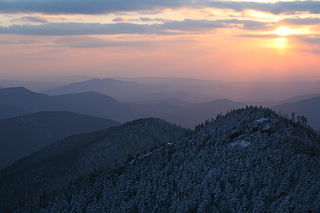
The Great Smoky Mountains are a mountain range rising along the Tennessee–North Carolina border in the southeastern United States. They are a subrange of the Appalachian Mountains and form part of the Blue Ridge Physiographic Province. The range is sometimes called the Smoky Mountains, and the name is commonly shortened to the Smokies. The Smokies are best known as the home of the Great Smoky Mountains National Park, which protects most of the range. The park was established in 1934 and, with over 11 million visits per year, is the most visited national park in the United States.

The Cherokee National Forest is a United States National Forest located in the U.S. states of Tennessee and North Carolina that was created on June 14, 1920. The forest is maintained and managed by the United States Forest Service. It encompasses an estimated area of 655,598 acres (2,653.11 km2).
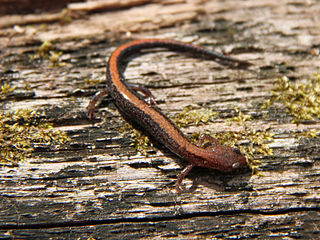
The southern red-backed salamander is a species of salamander endemic to the United States. It is found in four widely disjunct populations: one in central Louisiana; one in the Ouachita Mountains of Arkansas and Oklahoma; one in central Missouri; and one from southeastern Tennessee, to southwestern North Carolina, western Georgia, and eastern Alabama. It is sometimes referred to as the Georgia red-backed salamander or the Ouachita red-backed salamander. It was once considered a subspecies of the red-backed salamander, Plethodon cinereus.

The imitator salamander is a species of salamander in the family Plethodontidae. It is endemic to the Appalachian Mountains in the southeastern United States.
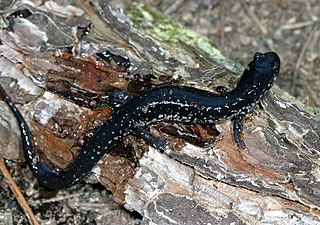
The white-spotted slimy salamander is a species of salamander in the family Plethodontidae endemic to the Eastern United States. It is one of 55 species in the genus Plethodon, and was one of the first to be described of its cogeners.
The valley and ridge salamander is a species of salamander in the family Plethodontidae endemic to the Appalachian Mountains in the eastern United States.

The red-cheeked salamander, also known as the Jordan's salamander, Jordan's redcheek salamander, or Appalachian woodland salamander, is a species of salamander in the family Plethodontidae. It is endemic to the Appalachian Mountains in the southeastern United States.

The southern gray-cheeked salamander is a species of salamander in the family Plethodontidae endemic to the area where North Carolina, South Carolina, and Georgia adjoin each other in the southeastern United States. The species has a known altitudinal range of 256 to 1,295 m in the mountains of the region. Where their ranges overlap, it hybridizes with P. jordani and P. teyahalee. Its natural habitat is temperate forests.

Plethodon punctatus, commonly known as the Cow Knob salamander or white-spotted salamander, is a species of salamander in the family Plethodontidae. It is endemic to high mountain forests on the border of Virginia and West Virginia in the United States. Nearly all occurrences are on Shenandoah Mountain, Nathaniel Mountain and Great North Mountain in George Washington National Forest. Cow Knob salamanders are a member of the P. wehrlei species complex, which includes many other Appalachian salamanders historically referred to Plethodon wehrlei.
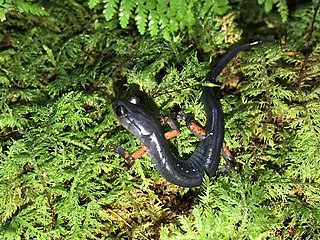
The red-legged salamander is a species of salamander in the family Plethodontidae. Formerly considered a subspecies of Plethodon jordani, it is native to the mountain forests of the southeastern United States.
The Shenandoah Mountain salamander is a species of salamander in the family Plethodontidae native to the eastern United States. It should not be confused with the Shenandoah salamander, which inhabits Shenandoah National Park, east of Shenandoah Mountain.

Weller's salamander is a species of salamander in the family Plethodontidae. This species in endemic to the southeastern mountain range of the United States. It is mainly found in North Carolina near Grandfather Mountain. The salamanders have a unique metallic spotting which distinguishes them from other Plethodon species and other salamanders in the area. They mainly inhabit cool forests with rocky areas.

The Yonahlossee salamander is a particularly large woodland salamander from the southern Appalachian Mountains in the United States. The species is a member of the family Plethodontidae, which is characterized by being lungless and reproductive direct development. P. yonahlossee was first described in 1917 by E.R Dunn on a collection site on Grandfather Mountain in North Carolina. The common and specific name is of Native American origin, meaning “trail of the bear”. It is derived from Yonahlossee Road northeast of Linville, where the specimen was first described.

The green salamander is a species of lungless salamander in the family Plethodontidae. It and the Hickory Nut Gorge green salamander are the only currently-described members of the genus Aneides that inhabit any areas in the eastern half of United States. Rarely seen in the field, the green salamander is an extremely habitat-specific species that is seldom found away from its preferred surroundings: moist, shaded rock crevices.
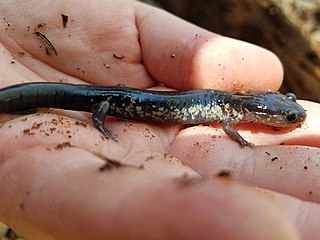
The Chattahoochee slimy salamander (Plethodon chattahoochee) is a species of salamander in the family Plethodontidae. It is endemic to the Appalachian Mountains in the United States, where it is found only in the Chattahoochee National Forest and Nantahala National Forest in the states of Georgia and North Carolina. Its natural habitat is temperate forests. It was once classified within the northern slimy salamander (P. glutinosus) until it was found to be a distinct species. Its range narrowly intersects with the northern slimy salamander, the Atlantic Coast slimy salamander (P. chlorobryonis), and the southern Appalachian salamander (P. teyahalee) and widely intersects with the red-legged salamander (P. shermani), and it is known to hybridize with the latter three.
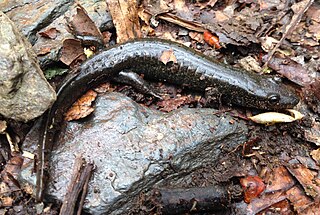
The Cherokee black-bellied salamander or Smoky Mountains black-bellied salamander is a species of lungless salamander in the family Plethodontidae. It is endemic to the eastern United States, where it is only known from the southern Appalachian Mountains.


















